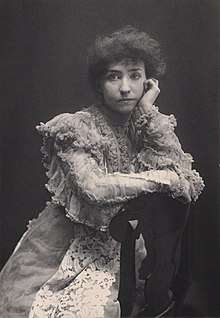Love Finds the Way
Love Finds the Way (originally titled The Right to Happiness) is a three-act play written by Marguerite Merington and first performed in 1896. Theatrical manager A. M. Palmer acquired the rights to a German play by Olga Wohlbrück, which Merington adapted into English. The adaptation debuted at the Grand Opera House in Wilmington, Delaware on November 30, 1896, with actress Minnie Maddern Fiske in the lead role.[1] The title was changed to Love Finds the Way for Broadway, where it opened at the Fifth Avenue Theatre on April 11, 1898, with A Bit of Old Chelsea by Mrs. Oscar Beringer as a curtain raiser. (Fiske starred in both plays.) Love Finds the Way is a comedy-drama about a young woman who seeks romance despite an injury that has left her unhappy and alienated from her family.[2]
| Love Finds the Way | |
|---|---|
 Publicity photo of Minnie Maddern Fiske in Love Finds the Way | |
| Written by | Marguerite Merington |
| Date premiered | November 30, 1896 |
| Place premiered | Grand Opera House, Wilmington, Delaware |
| Genre | Comedy-drama |
Cast and characters
The characters and cast from the Broadway production are given below:[2]
| Character | Broadway cast |
|---|---|
| Doctor Lee | Frederic De Belleville |
| Douglas Colbert | Forrest Robinson |
| Raymond Winfield | Verner Clarges |
| Edgar Townsend | George Trader |
| Simon | Wilfrid North |
| William | Frank McCormack |
| Leslie | Lotta Linthicum |
| Mrs. Bessell | Sydney Cowell |
| Madeline Winfield | Minnie Maddern Fiske |
| Helen | Alberta Gallatin |
| Jane | Dorothy Chester |
References
- "Opera House: Minnie Maddern Fiske in The Right to Happiness". Wilmington Morning Star. November 28, 1896. p. 1 – via Newspapers.com.
- "Some of the Easter Holiday Offerings of the Principal Theatres". The New York Times. April 12, 1898. p. 9.
External links
| Wikimedia Commons has media related to Love Finds the Way. |